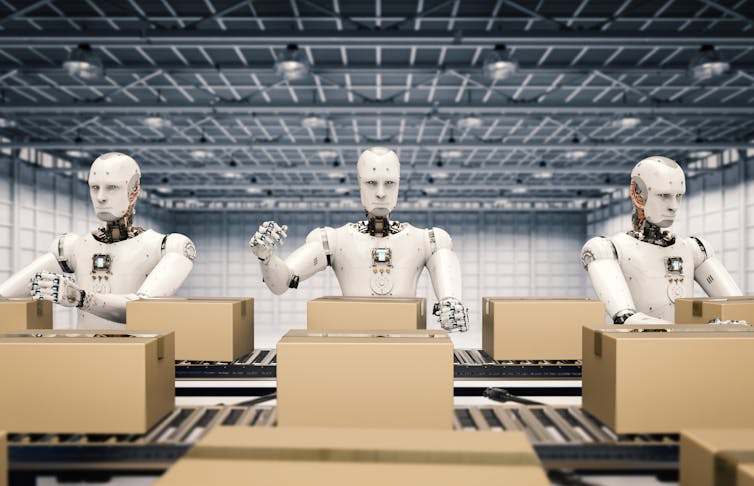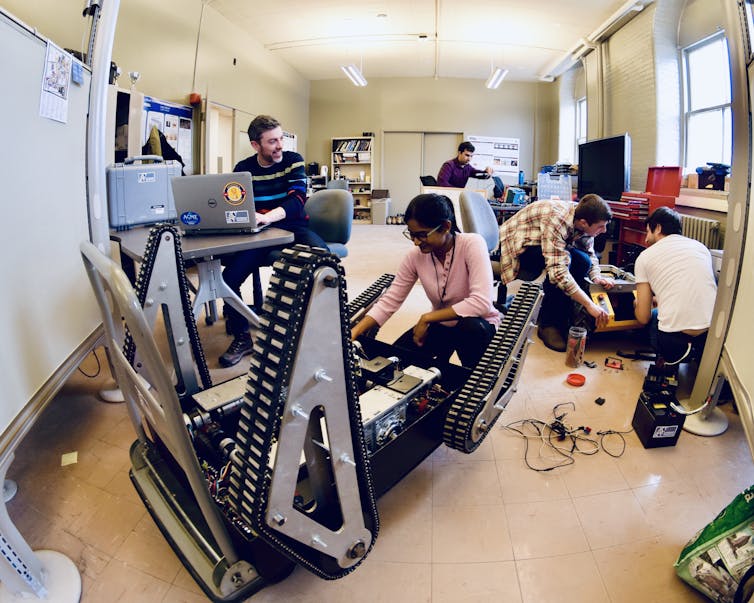How the ‘robot revolution’ is changing jobs and businesses in Canada
February 23, 2021
Share

In 2017, I returned to Canada from Sweden, where I had spent a year working on automation in mining. Shortly after my return, the New York Times published a piece called, “The Robots Are Coming, and Sweden Is Fine,” about Sweden’s embrace of automation while limiting human costs.
 Although Swedes are apparently optimistic about their future alongside robots, other countries aren’t as hopeful. One widely cited study estimates that 47 per cent of jobs in the United States are at risk of being replaced by robots and artificial intelligence.
Although Swedes are apparently optimistic about their future alongside robots, other countries aren’t as hopeful. One widely cited study estimates that 47 per cent of jobs in the United States are at risk of being replaced by robots and artificial intelligence.
Whether we like it or not, the robot era is already upon us. The question is: Is the Canadian economy poised to flourish or flounder in a world where robots take over the tasks we don’t want to do ourselves? The answer may surprise you.
Robots are everywhere
Modern-day robots are how artificial intelligence (AI) physically interacts with us, and the world around us. Although some robots resemble humans, most do not and are instead specifically designed to autonomously carry out complex tasks.
Over the last few decades, robots have rapidly grown from specialized devices developed for select industry applications to household items. You can buy a robot to vacuum your floors, cut your grass and keep your home secure. Kids play with educational robots at school, where they learn to code, and compete in robot design teams that culminate in exciting international competitions.
Robots are also appearing in our hospitals, promising to help us fight the COVID-19 pandemic and performing other health-care tasks in safer and more efficient ways.
The media is abuzz with stories about the latest technical claims, rumours and speculations about the secret developments of major international corporations, including Waymo, Tesla, Apple, Volvo and GM.
And NASA just landed the Perseverance rover on Mars, with an autonomous helicopter called Ingenuity attached to its belly.
Oh, and there are the dancing robots too, of course.
Robots behind the scenes
I have been working on robotics and autonomous vehicles technology in mining since the late 1990s. As such, I have been part of an industry that is undergoing a sea change, with fully autonomous machines steadily replacing workers in dark, dirty and dangerous scenarios.

This robot revolution is happening behind the scenes in other industries too. Robots fill Amazon orders, manufacture stuff in factories, plant and pick crops, assist on construction sites, and the list goes on.
In fact, robots even build other robots. Will we soon run out of jobs for people?
Robots in Canada
There are many who paint a bleak picture of the future, where robots and AI take away all the “good jobs.” Although I fully acknowledge that we must be mindful of possible inequalities and unintended outcomes that might arise as a result of new technologies, I contend that Canadians have the potential to thrive.
But to make it happen, my colleagues and I agree that our country needs a “robotics strategy.”
In 2017, Canada launched the world’s first national AI strategy. Called the Pan-Canadian Artificial Intelligence Strategy and costing $125 million, the strategy aims to strengthen Canada’s leadership in AI by funding institutes, universities and hospitals to meet key objectives.
In its 2020 list of future jobs, the World Economic Forum listed “robotics engineers” as No. 10, in close company with “AI and machine learning specialists.” In Canada, I see huge potential for our robotics industry, with companies such as Clearpath Robotics, OTTO Motors, Kinova, Robotiq and Titan Medical already world leaders in the design and manufacture of robots for purposes ranging from materials handling to surgery.
Beyond building robots, Canada’s most significant opportunities may lie in the increased adoption of robots into economically important industry sectors, including mining, agriculture, manufacturing and transportation.
And yet, Canada may be the only G7 country without a robotics strategy.
The robot revelation
As it turns out, there is hope. According to a November 2020 report from Statistics Canada, Canadian firms that employed robots have also hired more human workers, contrary to what you may instinctively believe. In fact, they hired 15 per cent more workers!
However, this does not mean that we can all sit back and relax. Along with the increased economic activity that robots bring to businesses comes a shift in the workforce from “workers spending less time performing routine, manual tasks, in favour of non-routine, cognitive tasks.”

The roles of education and research and development — such as new programs to train the next generation of robot-savvy Canadians and collaborative research clusters — are paramount. And they need to be combined with a national robotics strategy and a progressive socioeconomic system that supports a transitioning workforce to ensure the success, well-being and happiness of Canadians, alongside our robot friends.![]()
_________________________________________________________________
Joshua A. Marshall is as Associate Professor of Mechatronics and Robotics Engineering at Queen's University. He currently serves as Interim Director at the Ingenuity Labs Research Institute at Queen's University and is a founding member of the NSERC Canadian Robotics Network (NCRN).
This article is republished from The Conversation under a Creative Commons license. Read the original article.
The Conversation is seeking new academic contributors. Researchers wishing to write articles should contact Melinda Knox, Associate Director, Research Profile and Initiatives, at knoxm@queensu.ca.